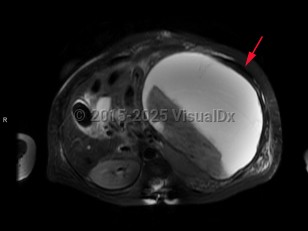Splenic infarction
Alerts and Notices
Important News & Links
Synopsis

A splenic infarction is an ischemic injury to the spleen. It most commonly presents with severe, sharp pain, with a quarter of patients presenting with classic left upper quadrant pain and about half with pain elsewhere in the abdomen; a significant portion have no abdominal pain. Radiation to the left shoulder may sometimes occur, called a Kehr sign. Leukocytosis and fever may also be present. Infarction may lead to rupture, which can cause life-threatening hemorrhage.
Forty percent of splenic infarction cases have more than one predisposing condition, diseases predisposing to embolus, abdominal inflammation, and sickle cell disease. Patients with sickle cell disease are most likely to develop chronic splenic microinfarcts. By the age of 5, these microinfarcts have usually left a patient with sickle cell disease functionally asplenic.
Treatment is typically supportive, with pain control being the main goal. Resources for opioid prescribing guidelines, as well as nonopioid alternatives, can be found here.
Forty percent of splenic infarction cases have more than one predisposing condition, diseases predisposing to embolus, abdominal inflammation, and sickle cell disease. Patients with sickle cell disease are most likely to develop chronic splenic microinfarcts. By the age of 5, these microinfarcts have usually left a patient with sickle cell disease functionally asplenic.
Treatment is typically supportive, with pain control being the main goal. Resources for opioid prescribing guidelines, as well as nonopioid alternatives, can be found here.
Codes
ICD10CM:
D73.5 – Infarction of spleen
SNOMEDCT:
22996003 – Splenic Infarction
D73.5 – Infarction of spleen
SNOMEDCT:
22996003 – Splenic Infarction
Differential Diagnosis & Pitfalls

To perform a comparison, select diagnoses from the classic differential
Subscription Required
Best Tests
Subscription Required
Drug Reaction Data
Subscription Required
References
Subscription Required
Last Updated:09/01/2020
Splenic infarction

